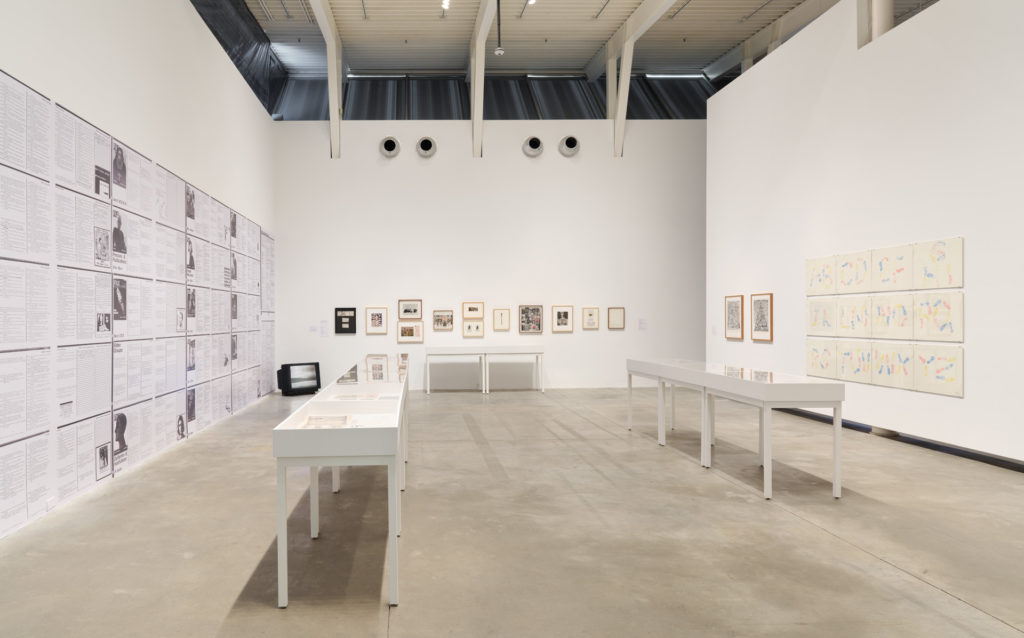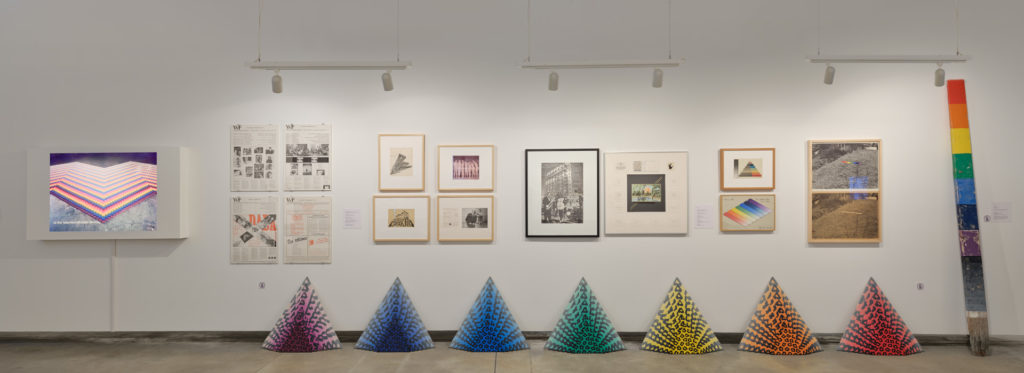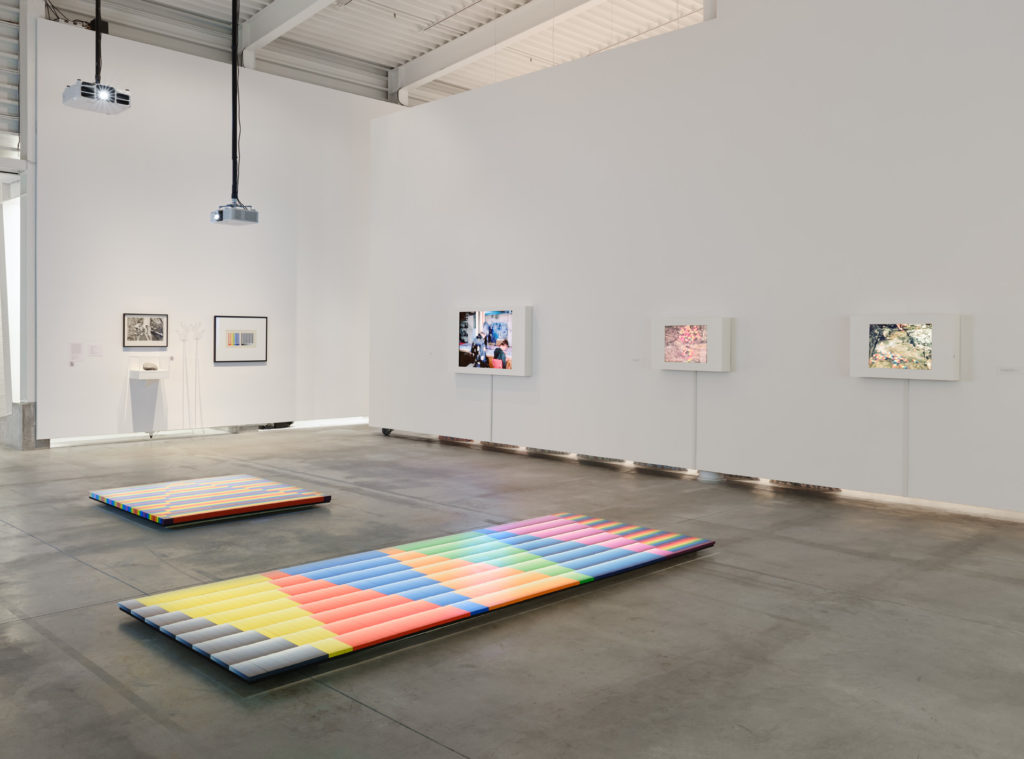23 Aug 2021
Image Bank: Reframing the Picture
By Marcus Prasad, Academic Programs Assistant
What is an image? This frustratingly abstract question was posed on my very first day of grad school and haunts me to this day. I was never able to piece together a solid answer during my studies, and now, three years later, taking a stab at it again only makes way for a series of additional questions: Does an image take a physical form? Are all images visual? Is every image a work of “art”? What, then, is art?
While ontological questions like this often leave me mildly nauseated, they’re made significantly more palatable by the Image Bank exhibition at the Belkin. I can’t say this was always the case. I can pretend that my command over works of various media is confident and unfaltering, but I was incredibly intimidated by the collection of Image Bank works when I first encountered them in 2018 as a Collections Assistant at the gallery. Boxes of postcards, letters, scribbled notes, pocket-sized photographs, newspapers and other ephemera were kept in storage and around the curatorial workroom. Even bigger boxes contained videotapes, props, costumes, colour bars and an eerie costume of Mr. Peanut. There was no easy way for me to enter into this vast array of things unified by the seemingly arbitrary label of “IMAGE BANK.”
Three years later, less concerned with the organization of these objects in storage and database procedures, I’m able to approach Image Bank from a more exploratory perspective. And really, the first step to this exploration is (re)considering the name itself. Image Bank is a bank of images. A large repository of visual objects, ephemera and things! But what is an image? Slow down, we’ll get there (eventually).
Upon entering the exhibition space, I’m struck by the collection of small pieces in vitrines. They encourage close looking, bending down to get your face even closer to the objects and ephemera. Photographs, postcards and handwritten notes find themselves interweaved tightly beneath the glass, careening between deliberate organization and random chaos. The prevailing concept of this room, for me, is an exploration of language, letters, words and their expanded possibilities. This may be because the works of typography recall the Stations exhibition held at the Belkin in the Spring, which partly explored how meaning is conveyed through text. In a similar vein, this first room encourages me to think about language and communication as a means to form a network of interconnected knowledges.

As described in the preface of the Image Bank publication, Image Bank provided a space for artists to intervene in mass media and its proliferation to oppose the more alienating effects of modern capitalist society. Reacting to the notion that the increased flood of imagery in the latter half of the twentieth century could homogenize society and enforce conformity, Image Bank reconfigured how we consume images by troubling and expanding its definition, along with the associated definitions of “art” and “artist.”
The first room of this exhibition asserts that art can be a letter written to a friend, a directory of contacts, a postage stamp on a homemade postcard or even a grocery list; pointing toward process rather than product, communication and collaboration over material object and singularity. Similarly, it asserts that anyone can be an artist, whether educated, practicing, non-practicing or otherwise. Every person participates in creating their own networks of images through a variety of different media that we all use on a frequent basis. A framing of artistic production as such allows us to democratize our perception of art, a perception that is so often restricted to the highbrow realm of the elite. When we think of these more banal things and experiences as art, reconfiguring their essences against what a curator can deem “appropriate,” the emancipatory possibilities outside of our capitalist realm of images become endless.
When entering the second gallery, this notion moves forward with greater force. Exploring the collages, fragments and sexual iconographies in this room allow us to think through images as constructions with varying levels of salience and meaning that can be toyed with and tested. Immediately, I am drawn to two postcard works by Gordon Matta-Clark, Post Cuts and Study for Post Cuts (1977). Cuts are characteristic of Matta-Clark’s practice, and I believe the inherently transformative nature of a cut speaks greatly to the aims of Image Bank. These works consist of instructions from the artist on how to make a “post cut,” directing the maker to create incisions into a postcard. A series of subversions immediately make themselves present – first, it uses destruction and absence as production and presence. The cut de-purposes the postcard and appears to weaken its materiality. While this kind of intervention would conventionally be considered to “ruin” the art object, here it is framed and prized as a novel work of art. The second subversion is that the work is a step-by-step manual on how anyone can make a Post Cut. As such, there is no revered artist who bestows their “master” hand on the work – instead, the maker can be anyone and anything, and perhaps most importantly, entirely anonymous.

I think of the cuts used in this work as a kind of methodology for the whole exhibition. When we cut into something, we intervene into its surface to fundamentally change its structure and essence. Image Bank is like an incision into the concept of the image – enacting a manipulation to reformulate how an image is understood, and what can figure into its categorical definition. Fragments and pieces become new works that reference what once was, incorporating the temporalities of the past and present to gesture toward a future that could be; one that sees a more optimistic horizon for the world of images.
In the final room, I see a culmination of the exhibition’s aims condensed into the colour bar and how it is figured across Image Bank’s existence. Through these multiple bands of varied tone and hue arranged in stunning compositions, we can begin to answer the contentious question that’s obsessed me for years: What is an image?

Hundreds of colour bars hand-painted by Image Bank artists are arranged in bright and large compositions along the gallery floor, accompanied by videos of them set up as props amongst various natural settings. These colourful objects directly refer to the colour-bar spectrum used to colour correct photographs. Traditionally, these spectrums rarely make it into the photographs themselves, acting merely as tools for editing and finalizing the images. Through Image Bank’s use of them however, the tool is brought into the work and made a key part of it. What was once a method of measuring colour for the process of developing photography is now a part of the photograph itself.
A wealth of implications come to the fore when we think of the role of the colour bar and its intrusion into the space of the image. When it is placed in conspicuous settings like this, it brings all of its surrounding objects and the spaces they inhabit into what we consider to be “the image.” By extension, this ultimately suggests that the space we exist in, too, is itself an image. By reversing the means of production to become part of the final product, the colour bar allows us to think through how everything we see and experience can be an image in their full spatial and temporal dimensionality. An image is no longer just a flat representation printed on paper or relegated by a frame. As such, the power of Image Bank is found in its disruption of the limitations of the image by foregrounding the role of space and time, pulling them through a perceived surface and into the realm of our lived experience.
As I walk through the third gallery, I approach the colour bars and think about how my body, perception and subjectivity are participating in their own creation of images. Not only do I take pictures of the exhibition with my phone, but I scribble notes, I talk about the works with my friends, I walk through this space and I write this article. All of these things constitute their own image networks that aren’t necessarily nor exclusively visual and two-dimensional. They are dynamic, intermedial, outside of linear time and ephemeral. While this complicates any concise answer to what an image is, maybe we can think about if there’s anything that isn’t an image. Is that better?